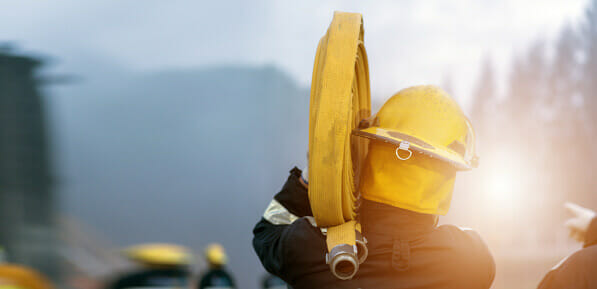There is no doubt that COVID-19 has and continues to have an impact on our lives. Whether affecting the health of individuals, causing interruptions in the supply chain, or facilitating instability in the global economy, the virus has had a profound effect on everyone. For obvious reasons, much of the pandemic-related research has focused on the virus’s impact on human health. However, one area deserving of more attention is its impact on workplace safety performance and management across wide-ranging industries such as shipping and manufacturing, to utilities & construction, and to automotive & retail. Understanding if we are more or less safe, as we look ahead to the post-pandemic workplace, will allow organizations and employees to adapt their injury prevention strategies and provide better protection for workers at all times.
The Impact of COVID-19 Economic Factors on Safety Programs
One of the many disruptions caused by the COVID-19 pandemic was what the World Economic Forum declared, “the Worst Global Recession since WWII” as early as June 2020. As the pandemic waned on, later stats validated that prediction and showed that the recession was indeed the largest since the great depression and had the sharpest decline ever (4.3%) in global GDP – or the equivalent of almost 3 trillion USD .
Bottom Lines & Job Security Versus Health & Safety
Underreporting is one of the ways a recession can impact safety performance. Researchers in the US and the EU have completed studies indicating that as many as 20% of workers fear harassment and risk of dismissal when reporting occupational injuries during periods of recession (Boone et al., 2011; Palali & Ours, 2017). In a study conducted in the United States, researchers reported that 21% of injured employees lost their job after filing an occupational injury claim during a recession and 25% of employees were discouraged by their employer to submit a claim (Hartzell et al., 2015). This form of “risk secrecy” can further facilitate an atmosphere of underreporting injuries, resulting in unsafe work environments not being rectified and a false sense of security in actual safety statistics (Dekker & Pitzer, 2016)
In a study conducted prior to the COVID-19 pandemic, over 2,000 mining employees identified their organizational leadership’s commitment to safety as one of the top factors to be improved for fatality prevention (Jenke et al., 2022). Participants were asked to score their perception on their organization’s effectiveness at fatality prevention from 1-10, 10 being the most effective. Perhaps not surprisingly, respondents in leadership roles scored their organization’s performance at fatality prevention higher than those in front line roles.
This same questionnaire has been provided to employees during the COVID-19 pandemic and preliminary analysis has revealed that economic pressures resulting in compromised safety is the top factor to be improved for fatality prevention. This suggests that the balance between workplace injury prevention, reducing economic costs, and increasing productivity is impacted by COVID-19.
For workers continuing to work during the pandemic, the prioritization of production continued especially in high-risk industries. The decrease in the workforce also resulted in longer shift lengths for many. And this, combined with the stressful environment and fatigue, is a recipe for more injuries. While COVID_19 has results in a stronger emphasis on PPE, hygiene, and physical distancing, the same workplace hazards in place prior to the pandemic are still risks and many are working in hazardous environments with less OH&S (Occupational Health & Safety) support.
In Closing
The pandemic has had a significant impact on both the economy and workplace safety. Organizations that do not design their injury prevention strategies to be resilient during economic changes, such as those brought on by COVID-19, may be surprised by a reduction in their effectiveness. In order to prioritize safety, organizational leadership should:
- Commit to providing a safe environment to report injuries, regardless of the economic climate.
- Ensure there are sufficient OH&S roles in place to maintain, monitor, and adapt safety management systems during a recession.
To hear more about this topic, join Tanya Jenke at Cority Connect where she will present more on her PhD research, which she is undertaking at Edith Cowan University in Western Australia.
References
Boone, J., van Ours, J. C., Wuellrich, J.-P., & Zweimüller, J. (2011). Recessions are bad for workplace safety. Journal of Health Economics, 30(4), 764.
Dekker, S., & Pitzer, C. (2016). Examining the asymptote in safety progress: a literature review. International Journal of Occupational Safety and Ergonomics, 22(1), 57-65. https://doi.org/10.1080/10803548.2015.1112104
Hartzell, M. M., Mayer, T. G., Neblett, R., Marquardt, D. J., & Gatchel, R. J. (2015). Does the economy affect functional restoration outcomes for patients with chronic disabling occupational musculoskeletal disorders? [journal article]. Journal of Occupational Rehabilitation, 25(2), 378-386. https://doi.org/10.1007/s10926-014-9546-1
International Labour Organisation. (2021). World Employment and Social Outlook Trends 2021.
International Organization for Standardization. (2018). ISO 31000 – Risk management.
Jenke, T., Boylan, J. L., Beatty, S., Ralph, M., Chaplyn, A., Penney, G., & Cattani, M. (2022). Fatality risk management: Applying Quinlan’s Ten Pathways in Western Australia’s mining industry. Safety Science, 146, 105494.
Jenke, T., Oosthuizen, J., & Cattani, M. (2021). An investigation of the influence of economic cycles on safety performance in Western Australia. Safety Science, 138, 105230.
Palali, A., & Ours, J. C. (2017). Workplace accidents and workplace safety: On under-reporting and temporary jobs. LABOUR, 31(1), 1-14.













